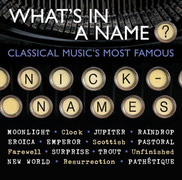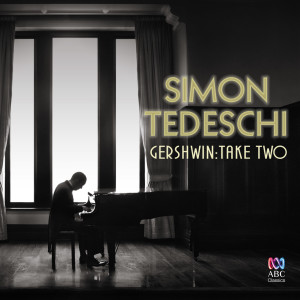What’s in a name? Nicknamed music on CD

Try referring to a piece of music by its key and opus number and you can be met with a blank look until you hum the tune or refer to it by its nickname. Opus numbers and keys are an essential part of the identity of a work, but nicknames can be a welcome aide memoire. Oft times, the composer has not been responsible for the nicknames. Instead, it has been another musician or critic who has devised the moniker. Or the names has simply appeared somewhere in history and has stuck.
ABC Classics have released a 2 CD anthology What’s in a Name? Classical Music’s Most Famous Nicknames (ABC Classics 480 5666) “to move on to first name terms with the music you love”.
Seventeen tracks from J S Bach to Gorecki cover single movements from some of their most popular alternatively titled compositions. Symphonic works dominate the collection – Haydn’s Surprise, Beethoven’s Pastoral, Mahler’s Resurrection and Dvorak’s New World, to name a few. Representing other genres are the second movement of Beethoven’s Emperor Concerto, the final movement of Schubert’s Trout Quintet, J S Bach’s Air on a G string and two piano works (the first movement of Beethoven’s Moonlight Sonata, and Chopin’s Raindrop Prelude). Soprano Yvonne Kenny features in the second movement of Gorecki’s Symphony of Sorrowful Songs. For choral music fans, excerpts from the final movement of Mahler’s Resurrection include the voices of mezzo-soprano Elizabeth Campbell, soprano Rosamund Illing and the Sydney Philharmonia Choir.
The collection is possibly especially valuable for some its performers and the time span it covers. The recordings date back to the early 1980s, some made live in concert. The Sydney, Melbourne and Adelaide Symphony Orchestras perform under Maestros Challender, Caetani, Otaka and Yuasa. The Tasmanian Symphony Orchestra performs with two of its past resident conductors, David Porcelijn and Sebastian Lang-Lessing and guest conductor David Stanhope, who also plays the Moonlight. John Champ performs the Raindrop and Gerrard Williams is the soloist in the Emperor,with Sinfonia Australia conducted by Anthony Walker. There is a handful of overseas performers, notably the Berlin Philharmonic with Karajan and the London Philharmonic Orchestra under Solti.
Happily, comprehensive insert notes explain the roots of the nicknames along with the full title of the work and the featured movement.
What’s in a Nameis ideal for those wanting to learn more about classical music – to become familiar with some of the great themes. If a nickname is a simple way of describing something in terms of its attributes, then this CD illustrates how using catchy descriptors can de-mystify the great works.
See separate post on the chance to win your own copy of What’s in a Name? Classical Music’s Most Famous Nicknames.







